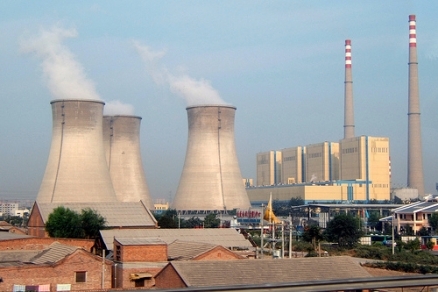Industrial Power and Emissions
Industrial Power and Emissions
| Topics: |

Power plant near Beijing, China. Credit: http://www.flickr.com/photos/bretarnett/ / CC BY-NC-SA 2.0
Many heavy industries have relocated from developed countries such as the United States and Japan to developing countries such as China and India to benefit from the latter’s lower labor costs and less stringent environmental regulations. Heavy industries are highly energy intensive. Consequently, greenhouse gas emissions from electric power generation are burgeoning in China and India.
China, in 2006 alone, added power-generating capacity that equaled the sum total of France's electricity grid. [1] Similarly, India doubled its power generating capacity between 1990 and 2000. [2] Coal-fired power plants provide over 80% of the new capacity in China and India. [2] Coal-fired plants also generate half of the electricity in the United States. Such plants, in comparison with other types, have higher greenhouse gas emissions per unit of power generated but are cheaper to construct and operate. Coal is an attractive energy source for China, India, and the United States because these countries have much larger reserves of coal than of gas, oil, or uranium. China plans to build 500 additional coal-fired electric power plants during the next decade, nearly one new plant per week. [1] India plans to double its capacity over the next decade. [2]
Power plants of all types have a life span of 30 to 50 years. Installing sophisticated equipment to abate greenhouse gas emissions during the initial construction is far cheaper than retrofitting older plants with such equipment. Therefore, decisions made about new power plants in China or India today will influence greenhouse gas emissions for generations to come. International agreements including the Kyoto Protocol provide economic incentives for incorporating cleaner technologies into new power plants.
[1] Campbell, G. (2007) New Coal Power Plants—A Global View. Commodities Now, http://www.commodities-now.com/content/market-news/market-news-20070730141838.php?PHPSESSID=6c208de26b605cde1b43df3aa135d0ad, accessed Oct. 1, 2007.
[2] Kroeze, C., J. Vlasblom, J. Gupta, C. Boudri, and K. Blok (2004) The power sector in China and India: greenhouse gas emissions reduction potential and scenarios for 1990-2020. Energy Policy 32:55-76.
This is an excerpt from the book Global Climate Change: Convergence of Disciplines by Dr. Arnold J. Bloom and taken from UCVerse of the University of California.
©2010 Sinauer Associates and UC Regents

0 Comments